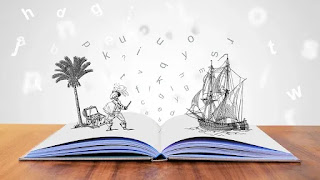Contents of Reading Comprehension
There are some contents of reading comprehension as follows:
a. Recognizing Word in Context
The
words around a new word are context. It can give the readers some clue to its
meaning. A word generally appears in a context related to its meaning. The
context suggested the meaning to you. Context can also affect the meaning of a
word the readers know. The word key, for instance, has many meanings. There are
musical keys, door keys, and keys to solving a mystery. The context in which
key occurs will tell the readers which meaning is right.
Sometimes
a hard word will be explained by the words that immediately follow it. The
readers can figure out that the second part of sentence explains the meaning of
a word. In addition, the subject of a sentence and the readers’ knowledge about
that subject might help the readers determine the meaning of an unknown word.
b. Distinguishing Fact from Opinion
Every
day people are called upon to sort fact and opinion. What we read and hear
contains both facts and opinions, we need to be able to tell them apart. It
needs skill of distinguishing fact from opinion.
Facts
are statements that can be proved true. The proof must be objective and
verifiable. The readers must be able to check for them to confirm a fact.
Opinions
are statements that cannot be proved true. There is no objective evidence the
readers can consult to check the truthfulness of an opinion. Unlike facts,
opinions express personal beliefs or judgments. Opinions reveal how someone
feels about a subject, not the facts about that subject. People might agree or
disagree with someone’s opinion, but the readers cannot prove it right or
wrong.
c. Keeping Events in Order
Writers
organize details in a pattern. They present information in a certain order.
Recognizing how writers organize and understanding that organization can help
the readers improve their comprehension.
When
details are arranged in the precise order in which they occurred, a writer is
using a chronological (or time) pattern. A writer may, however, change this
order. The story may “flash back” to past events that affected the present. The
story may “flash forward” to show the results of present events. The writer may
move back and forth between past, present, and future to help the readers see
the importance of events.
d. Making Correct Inferences
Much
of what people read suggests more than it says. Writers do not always state
outright what they want the readers to know. Frequently, they omit information
that underlies statements they make. They may assume that the readers already
know it. They may want the readers to make the effort to figure out the implied
information. To get the most out of what the readers read, they must come to an
understanding about unstated information. You can do this through inference.
From what is stated, the readers make inferences about what is not.
Furthermore,
the readers must be careful about the inferences they make. One set of facts
may suggest several inferences. Not all of them will be correct, some will be
faulty inferences. The correct inference is supported by enough evidence to
make it more likely than other inferences.
e. Understanding Main Ideas
The
main idea tells who or what is the subject of the paragraph or passage. The
main idea is the most important idea, the idea that provides purpose and
direction. The rest of the paragraph or passage explains, develops, or support
the main idea. Without a main idea, there would be only a collection of
unconnected thoughts. It would be like a handle and a bowl without the “idea
cup,” or bread and meat without the “idea sandwich.”
In a
paragraph, the main idea statement may appear fist and it is followed by
sentences that explain, support, or give details. However, sometimes the main
idea appears at the end of a paragraph. Writers often construct that type of
paragraph when their purpose is to persuade or convince. Readers may be more
open to a new idea if the reasons for it are presented first. In other
paragraph, it is started by supporting ideas. Their purpose is to convince the
reader that the main idea in the last sentence should be accepted.
In
many cases, the main idea is not expressed in a single sentence. The reader is
called upon to interpret all of the ideas expressed and decide upon a main
idea.
Understanding
the concept of the main idea and knowing how to find is important. Transferring
that understanding to our reading and study is also important.[1]


No comments for "Contents of Reading Comprehension"
Post a Comment